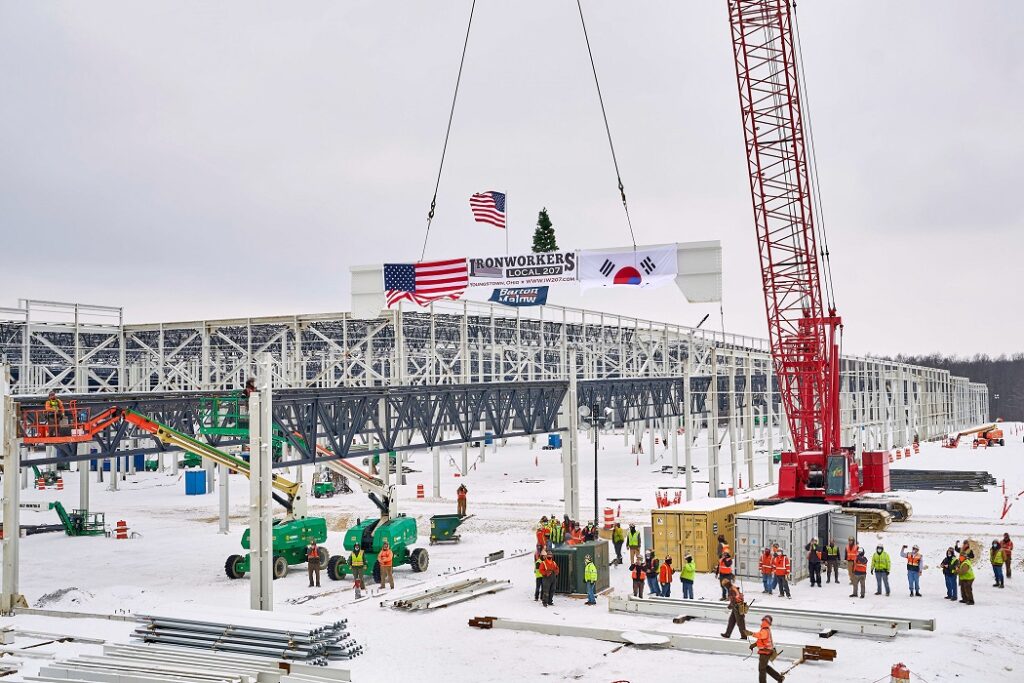 LG Energy Solution sees lithium iron phosphate (LFP) battery production to meet demand for stationary energy storage systems (ESS) in the US market as a “new growth engine” for the South Korean manufacturer.
LG Energy Solution sees lithium iron phosphate (LFP) battery production to meet demand for stationary energy storage systems (ESS) in the US market as a “new growth engine” for the South Korean manufacturer.The South Korean company announced its Q1 2023 financial results today, reporting KRW633 billion (US$470 million) operating profit from consolidated revenues of KRW8.747 trillion. EBITDA was KRW1,149 billion, versus KRW676 billion in the same quarter of the previous year and 13.1% up from the previous quarter.
The company emphasised the importance of the US electric vehicle (EV) market in growing sales, where it has established a manufacturing presence since 2012. Indeed, last October LG Energy Solution highlighted that the US was considered the most important market by the company, aiming to put 45% of its global footprint in the US, with 35% in Asia and 25% in Europe.
More recently, it hailed the coming online of a manufacturing plant in Ohio through its Ultim Cells joint venture (JV) with General Motors, but perhaps more importantly emphasised the impact of the Inflation Reduction Act’s (IRA’s) tax credits.
Yesterday’s financial results are LG Energy Solution’s first in which the value of tax credits will be reflected in reported revenues. LG Energy Solution said of its Q1 operating profit of KRW633 billion, just over KRW100 billion would be the estimated tax credit amount.
LG Energy Solution expects between 15GWh to 20GWh of its batteries manufactured in the US will qualify for advanced manufacturing production tax credits in 2023, including higher rates payable for use of domestic content.
While it doesn’t break out figures for its energy storage system (ESS) business in its quarterly reports – as yet – LG Energy Solution (LG ES) management offered some thoughts on the company’s ESS strategy in an earnings call to explain results.
Again, emphasising the importance of the US market, the company said in a presentation that developing lithium iron phosphate cells for stationary battery energy storage systems (BESS) was one of its “key initiatives” and a “new growth engine”.
So far, the company is building a plant in Arizona with 43GWh total annual production capacity, including 16GWh for BESS-bound LFP cells among its plans for 250GWh annual production capacity in the US that it has committed to.
‘LFP for ESS can be profitable line of business’
An analyst asked on the company’s earnings call if LFP cells for ESS could be profitable, since the capex required for LFP is higher than for nickel manganese cobalt (NMC) on a per-GWh basis.
A representative of the LG Energy Solution ESS battery planning and management team said that while it is true LFP cells have about 20% lower energy density than NMC, therefore dividing capex by capacity gives a higher per-gigawatt-hour capex for LFP, the lower cost of raw materials and simpler structure of lithium iron phosphate makes it cost competitive.
Additionally, the company representative said, LG ES will be producing locally in the US, meaning savings on import tariffs and various logistics costs, as well as making its products eligible for tax credits.
“So as a result of that all in all, we do think that we will be able to secure margins and also a sufficient level of profitability that is required for this business.”
Looking at the overall size and growth potential of the ESS market, LG Energy Solution is expecting North America to be “one of the main areas,” driving the company to establish a local production base.
In terms of competitiveness, LG Energy Solution will have a differentiated product, the representative claimed, and additionally plans to “engage upon long term supply agreements with large or large volume and very key customers,” while also establishing mid to long-term cooperations and partnerships in the market to get early or advance visibility on customer project pipeline opportunities.
On a related note, Kim Jong Hoon at LG ES’ advanced automotive battery planning and management team said some of the EV market, particularly in China, has moved towards adopting LFP batteries. While LG ES is actively exploring combining the benefits of LFP chemistry with pouch-type form factors in response to customer requests, however, the bigger opportunity for LFP lies with stationary energy storage.
“If you look at the type of LFP that we are trying to develop and focus on, the first priority right now would be to apply LFP to ESS batteries,” Kim Jong Hoon said.